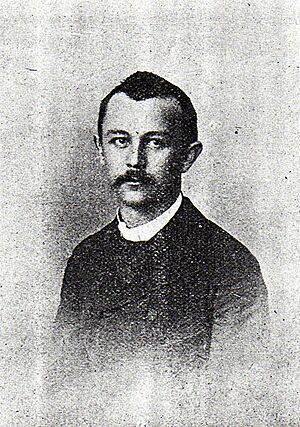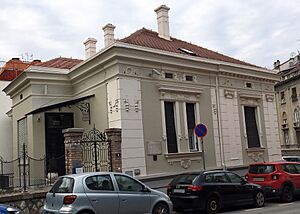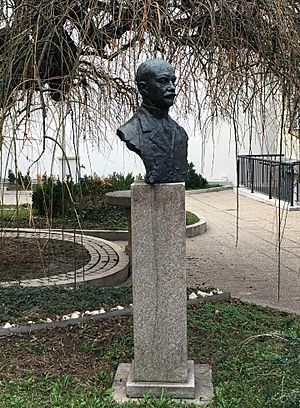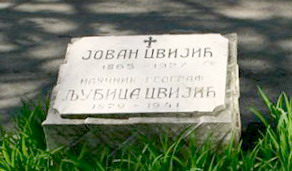Jovan Cvijić facts for kids
Quick facts for kids
Jovan Cvijić
|
|
|---|---|
| Јован Цвијић | |

Photograph by Milan Jovanović (1911)
|
|
| Born | 11 October 1865 Loznica, Principality of Serbia
|
| Died | 16 January 1927 (aged 61) |
| Resting place | New Cemetery, Belgrade, Serbia |
| Nationality | Serbian |
| Alma mater | Belgrade Higher School University of Vienna |
| Scientific career | |
| Fields | Geography, geology, folklore |
| Doctoral advisor | Albrecht Penck |
| Notable students | Pavle Vujević |
| Influences | William Morris Davis Eduard Suess |
| Signature | |
Jovan Cvijić (Serbian Cyrillic: Јован Цвијић, pronounced [jǒʋan tsʋǐːjitɕ]; 11 October 1865 – 16 January 1927) was a famous Serbian geographer and ethnologist. He was the president of the Serbian Royal Academy of Sciences. He also served as the rector (head) of the University of Belgrade.
Jovan Cvijić is known as the founder of geography in Serbia. He started his scientific journey studying the Earth's features as a geographer and geologist. Later, he focused on how people live and interact with their environment, becoming a human geographer and sociologist.
Contents
Early Life and Family
Jovan Cvijić was born in Loznica, a town in the western part of what was then the Principality of Serbia. His family came from a group called the Piva tribe in a region known as Old Herzegovina.
His father, Todor, was a merchant. His grandfather, Živko, was an important leader in Loznica. Cvijić's great-grandfather, Cvijo Spasojević, was a brave hajduk (a type of rebel leader). He fought against the Ottoman Empire in the First Serbian Uprising. After the uprising failed, he moved to Loznica and started a new life there.
Jovan's mother, Marija, came from a family in the Jadar region. Jovan often said that his mother and her family greatly influenced his early education and thinking.
Education and Early Work
After finishing elementary school, Cvijić went to grammar school in Loznica. There, he became interested in literature and learned French and German. He continued his studies in Šabac before moving to Belgrade. He graduated from the First Belgrade Gymnasium in 1884.
He initially wanted to study medicine. However, he couldn't get a scholarship to study abroad. A teacher suggested he study geography at the Velika skola (now the University of Belgrade). Cvijić followed this advice. He enrolled in the natural sciences department and finished his studies in 1889.
After graduating, Cvijić taught at a grammar school in Belgrade. During this time, he traveled to eastern Serbia. This trip sparked his interest in the Karst landscape, leading him to publish his first geography paper in 1889.
He then went to Vienna University to study physical geography and geology. He learned from famous scholars like Albrecht Penck. Cvijić earned his PhD from Vienna University in 1893. His doctoral paper, Das Karstphänomen, was very important. It helped start a new field of study called Karst geomorphology.
After his studies, Cvijić traveled around the Balkans. He conducted fieldwork and research, exploring the region's geography. In 1911, he married Ljubica Nikolić.
Important Research

Cvijić's research covered several key areas:
- Karst: Studying unique landscapes made of soluble rocks like limestone.
- Glaciations: Looking for signs of ancient glaciers in the Balkan mountains.
- Tectonic elements: Understanding how the Earth's crust moves and shapes the land.
- Lakes: Investigating the formation and features of lakes.
- Human geography: Exploring how people live and move across the land.
Much of his work was challenging. He faced political tensions and traveled through dangerous, remote areas. Good maps were also hard to find.
His detailed study of limestone karst was highly praised by scientists in Europe. He became known as the first South Slavic expert in tectonics.
Cvijić also did pioneering work in human geography. He studied the different types of people living in the Balkans. He spent 38 years researching, leading expeditions across the Balkans and other regions. His two-volume book, Geomorphology, is a key resource for studying the Balkan peninsula.
Karst Geomorphology
When Cvijić studied in Vienna, his professor, Albrecht Penck, encouraged him to focus on karst features. Karst landscapes are formed when water dissolves soluble rocks, creating caves, sinkholes, and unique landforms.
His first major work on this topic was Das Karstphänomen, published in 1893. This book was based on his PhD thesis. It described landforms like karren (grooves in rock), dolines (sinkholes), and poljes (large flat plains in karst areas).
In 1918, Cvijić suggested a cyclical model for how karst landscapes develop over time. He also helped make the term "karst" widely used in science. He introduced the term "doline" for sinkholes, which is still used today. Because of his important contributions, Cvijić is often called the "father of karst geomorphology."
Human Geography
At the same time, Cvijić became very interested in the lives of people in the Balkans. He traveled to many places, including Macedonia, Albania, and Greece. In 1902, he published his first work on human geography. His important book, Basics of Geography and Geology of Macedonia and Old Serbia, came out in 1906. It became a key reference for future researchers.
Cvijić believed that human life is strongly influenced by climate and geography. He studied how the physical environment affects people's minds and ways of life. He also looked at social structures like work, marriage customs, and migration.
He introduced the term 'metanastasic movements'. This describes the slow, gradual movement of people from one place to another. He and his students explored this idea widely. Their work helped create the Serbian ethnological-historic school, which collected information about people and their history across the Balkan peninsula.
Cvijić's work in human geography and ethnography was a major achievement. His research gathered important information that he used after World War I.
Influence on Country Borders
After World War I, Jovan Cvijić was invited to the Paris Peace Conference (1919–1920). He was an expert on how to draw new country borders. Using maps that showed where different groups of people lived, Cvijić helped decide the borders of a new country. This country became the Kingdom of Serbs, Croats and Slovenes. His work helped ensure that many South Slavic people were included in this new state.
Teaching and University Leadership
In March 1893, after returning from Vienna, Cvijić became a professor at the Velika Skola in Belgrade. He taught geography there until 1927.
Cvijić played a big role in improving the school. He helped create an ethnography department. He also influenced the establishment of five new university faculties (departments) in Belgrade and other cities. He served as the rector (head) of Belgrade University twice, from 1906 to 1907 and again from 1919.
In 1915, he gave lectures about the Balkans at Sorbonne University in Paris.
Views on Education
Cvijić had strong opinions about education. He believed that grammar school (high school) should be seven years long instead of eight. He felt that young people should start adult life and independent work earlier.
Grammar school shapes intelligence and character perhaps even deeper and stronger than university. It influences the spirit and moral value of future intellectuals. The moral and spiritual situation and its development depend on the type of grammar school. This will determine what civilization will gain, and whether it will slow or interfere with the development of great personalities, who show the true qualities of a nation.
He also wrote detailed guides for his colleagues on how to conduct field research about people and their living places.
Legacy and Honors
You should get used to constant thinking about a problem, work, or profession until you find a solution. There are bright moments, especially bright nights, which are rare; where you can find an answer to a question or come up with a research plan. That time of spiritual clarity and creativity should be used, and not wasted by thinking about rest or ordinary laziness. This does not hurt the body, and if it does hurt, the body exists in order to be spent properly.
In 1910, Cvijić and a group of other scientists founded the Serbian Geographic Society in Belgrade. He was its president until he passed away. In 1912, he started a magazine called the Serbian Geographic Society Herald, which is still published today.
He also held weekly seminars for science students. These were also attended by teachers from Belgrade grammar schools. In 1923, he founded the Geographical Institute at the Faculty of Philosophy, the first of its kind in the Balkans. He managed it until his death.
In 1947, the Serbian Academy of Sciences and Arts established the Jovan Cvijić Geographical Institute in Belgrade to continue his work.
The Jovan Cvijić's house in Belgrade is now a museum. It was built in 1905 and is considered a cultural monument. The house is decorated with a style based on Balkan folklore. The museum displays his manuscripts, letters, books, maps, and personal items. Lectures are also held there.
Many schools and streets in Serbia are named after Jovan Cvijić. He is still seen as the most important Serbian geographer. His students continued his work, and several of them became members of the Serbian Academy.
Academic Honors
Jovan Cvijić received many awards and honors during his life. He was a member of 30 scientific societies, including academies and geographical societies. He received ten decorations.
Some of his notable awards include:
- 1917: Medal of Geographical Society of Paris
- 1920: Patron's Medal of the Royal Geographical Society (England)
- 1924: Cullum Geographical Medal (USA)
- 1924: Gold medal of the American Geographical Society, New York
He was also named:
- Honorary doctor of the University of Paris
- Honorary doctor of the Charles University in Prague
- Member of the Serbian Royal Academy
- Corresponding Member of the Yugoslav Academy of Sciences and Arts
- President of the Serbian Royal Academy from 1921 until his death
Works
Jovan Cvijić published many scientific works during his career. One of his most famous books is The Balkan Peninsula. Some of his other important publications include:
- Das Karstphänomen (The Karst Phenomenon), 1893.
- Karst, geografska monografija (Karst, a Geographical Monograph), 1895.
- Osnove za geografiju i geologiju Makedonije i Stare Srbije (Foundations for the Geography and Geology of Macedonia and Old Serbia), 1906.
- La Peninsule Balkanique, Geographie Humaine (The Balkan Peninsula, Human Geography), 1918.
- Geomorfologija I-II (Geomorphology I-II), 1924 and 1926.
Images for kids
See also
 In Spanish: Jovan Cvijić para niños
In Spanish: Jovan Cvijić para niños








